Chad is a landlocked country in North-central Africa with diverse bird species. Home to a variety of habitats ranging from savannah to wetlands and deserts, Chad provides an ideal environment for various birds to thrive.
In this article, we will explore some of the unique and interesting bird species found in Chad. From the glittering starlings to the helmeted guinea fowl, Chad has a wealth of avian diversity.
Whether you’re a birdwatcher or a nature enthusiast, Chad’s birdlife is sure to captivate and inspire you.
So, let’s take a closer look at some of the birds that call this African country home.
1. Hamerkop
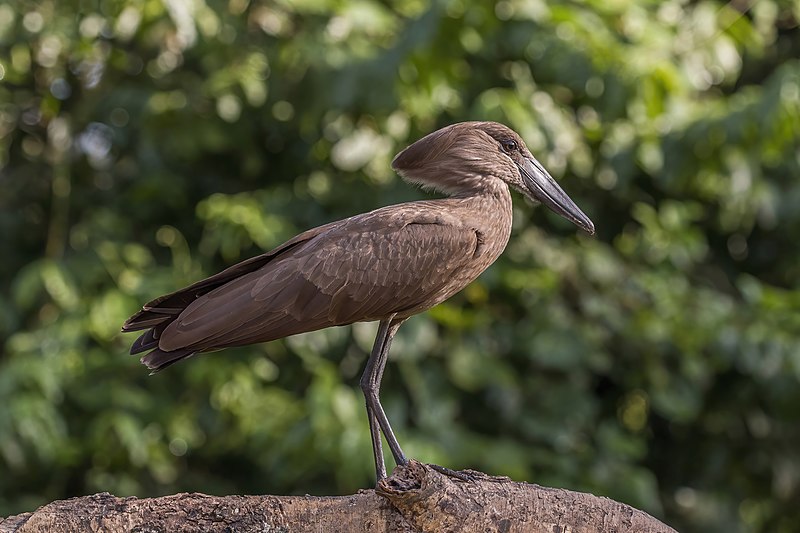
The Hamerkop is a unique wading bird found across sub-Saharan Africa and as far east as India.
It has an unmistakable silhouette, with its long bill topped by a crest at the back of its head that gives it the look of a hammerhead shark.
Its plumage consists mainly of browns and greys, providing excellent camouflage in reed beds.
The species was once classified alongside storks but is now believed to be closely related to pelicans and shoebills instead.
This medium-sized bird feeds on insects, fish, frogs, or small reptiles which it captures from shallow water or plucks from trees near bodies of water.
Despite being considered ‘unlucky’ by some cultures due to superstition surrounding their appearance they are quite important for controlling populations of certain pests.
Scientific classification:
| Kingdom | Animalia |
| Phylum | Chordata |
| Class | Aves |
| Order | Pelecaniformes |
| Family | Scopidae |
| Genus | Scopus |
| Species | S. umbretta |
Also Featured In: Common Nigerian Birds, African Birds
2. Red-Throated Bee-Eater
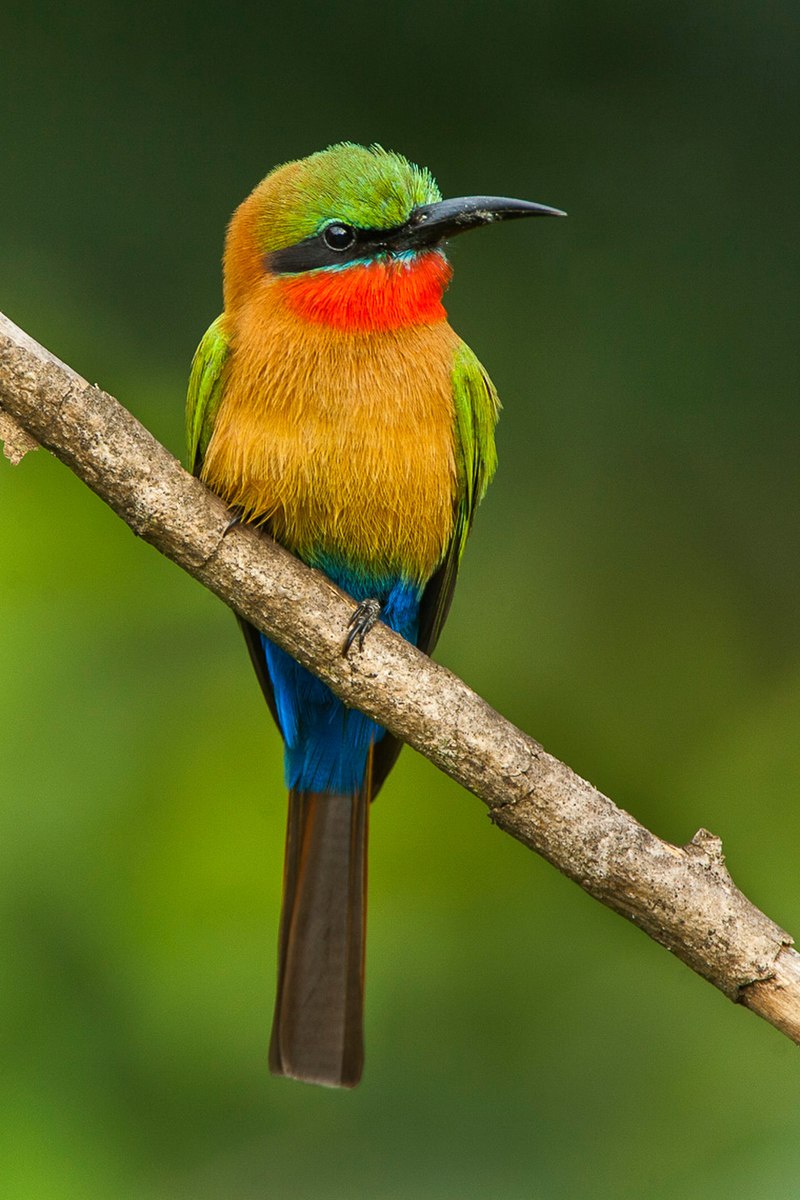
The Red-throated Bee-eater is a beautiful species of bird found in tropical Africa. It has bright red feathers covering its throat, giving it a distinct look.
Its body is mostly brown with white stripes and its wings are dark blue on the tips.
This species enjoys an extensive range throughout countries like Benin, Burkina Faso, and Togo to name just a few.
These birds feed mainly on insects that they catch in midair or from nearby foliage during their hunting flights over open country habitats such as woodlands and savannas.
While not much else is known about this particular type of bee-eater, these colorful creatures have surely become quite popular due to their striking beauty.
Scientific classification:
| Kingdom | Animalia |
| Phylum | Chordata |
| Class | Aves |
| Order | Coraciiformes |
| Family | Meropidae |
| Genus | Merops |
| Species | M. bulocki |
Also Featured In: Birds of Côte d’Ivoire,
3. African Paradise Flycatcher
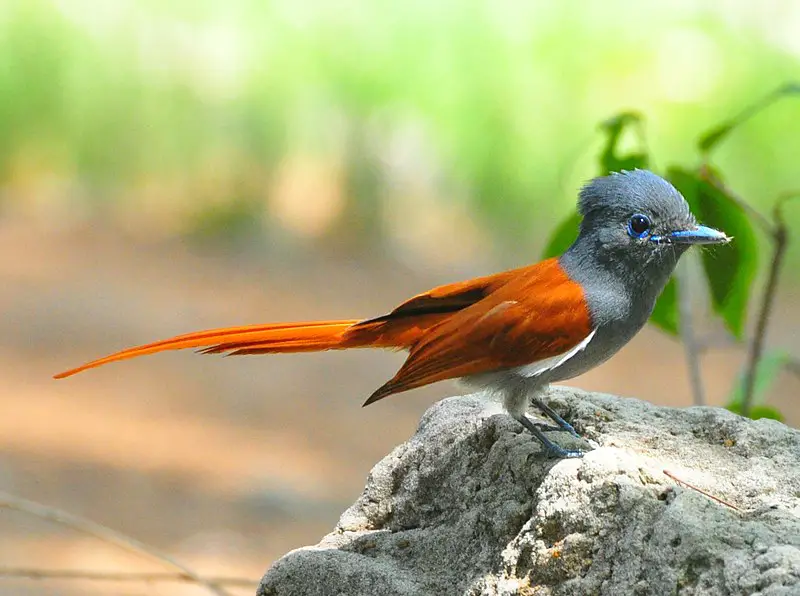
The African paradise flycatcher is a beautiful passerine bird, with the males having tail feathers that extend into streamers twice as long as its body.
Males have chestnut or rusty-colored upper parts on their wings and tails, contrasting nicely against the whitish underparts of both genders.
The head and throat are black for adult males, while females lack this coloration but feature some orange-red streaking instead.
Both sexes bear red eyes and blue-grey legs and feet to round out their appearance.
These birds mainly inhabit tropical forests throughout Sub-Saharan Africa where they feed primarily on insects such as beetles, ants, and cicadas; occasionally supplementing it with small fruit when available during certain times of year.
Scientific classification:
| Kingdom | Animalia |
| Phylum | Chordata |
| Class | Aves |
| Order | Passeriformes |
| Family | Monarchidae |
| Genus | Terpsiphone |
| Species | T. viridis |
Also Featured In: Common Ethiopian Birds, Birds of KwaZulu-Natal
4. Northern Carmine Bee-Eater
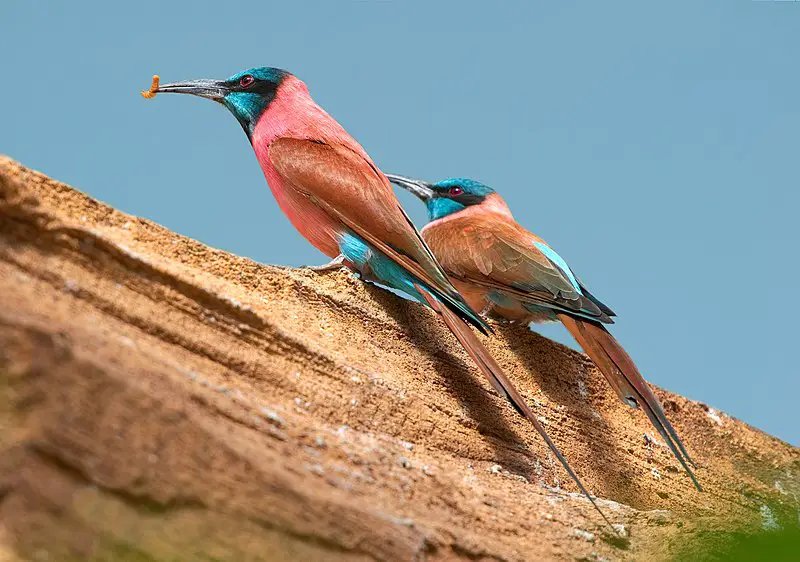
The Northern Carmine Bee-eater is a beautiful bird with striking colors. It has bright red and blue plumage, with the throat being predominantly carmine in color.
This species of bee-eater can be found throughout northern tropical Africa, from Senegal east to Somalia, Ethiopia, and Kenya.
It was previously assumed to be closely related to the Southern Carmine Bee-eater which has a scarlet-colored throat instead of blue as seen in this species.
The Northern Carmine Bee-Eater feeds on flying insects such as bees and other small creatures that it catches midair using its sharp claws and bill to grab them quickly before they escape.
Scientific classification:
| Kingdom | Animalia |
| Phylum | Chordata |
| Class | Aves |
| Order | Coraciiformes |
| Family | Meropidae |
| Genus | Merops |
| Species | M. nubicus |
Also Featured In: Common Kenyan Birds,
5. Speckled Pigeon
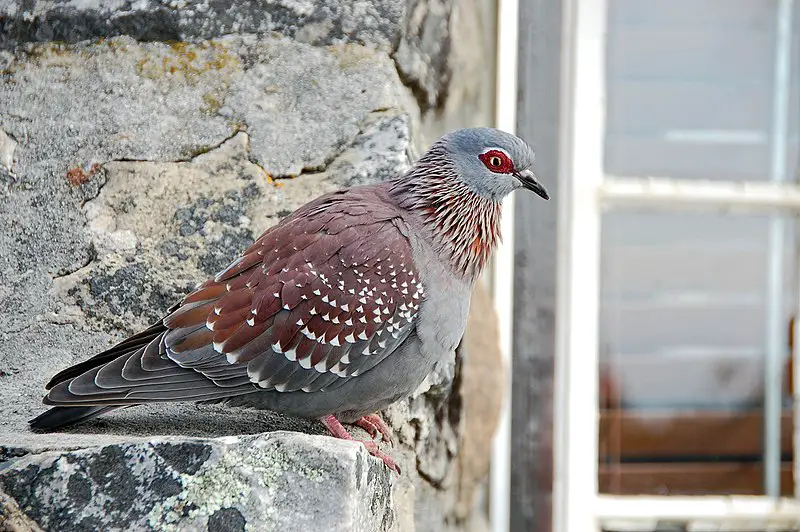
The Speckled Pigeon, also known as the African Rock Pigeon or Guinea pigeon due to its similar coloring to some species of guineafowl, is a resident breeding bird in much of Africa south of the Sahara.
It’s commonly seen inhabiting open habitats and has been around since 1747 when it was first described by Swedish naturalist Carl Linnaeus.
These birds usually have grey bodies with speckles on their wings, although they can vary from brownish-grey to dark slate blue depending on where they’re found geographically.
They feed mostly on seeds and other grain crops but will sometimes supplement that diet with insects if available.
In general, these pigeons are harmless unless threatened – so be sure not to startle them.
Scientific classification:
| Kingdom | Animalia |
| Phylum | Chordata |
| Class | Aves |
| Order | Columbiformes |
| Family | Columbidae |
| Genus | Columba |
| Species | C. guinea |
6. White-throated bee-eater
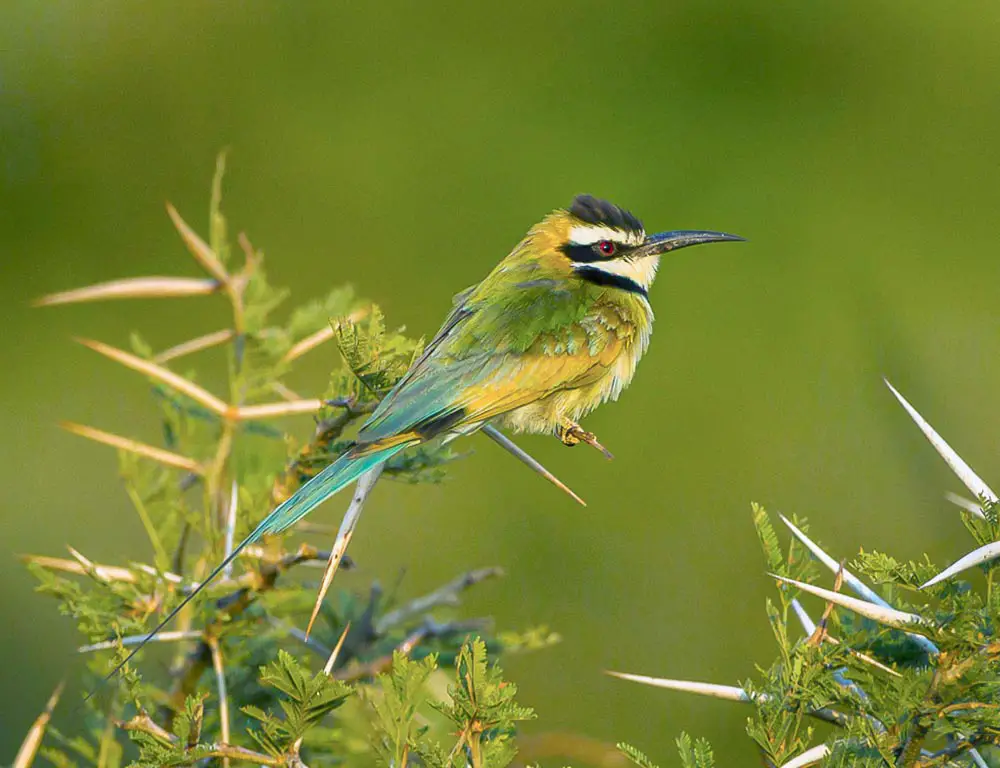
The White-throated bee-eater is a stunningly colorful bird that belongs to the Meropidae family in the near passerine category.
It breeds in semi-desert regions along the southern Sahara and migrates during winter months to equatorial rain forests from Senegal to Uganda, where it enjoys different habitat experiences.
Its plumage consists of bright blues, greens, and yellows with a distinctive white throat patch which gives it its name.
They feed on insects such as bees, dragonflies, and wasps by catching them mid-flight or plucking them off vegetation before returning to their perch spot for eating; they perform aerial acrobatics while hunting.
These birds are social creatures who form colonies when breeding season arrives around springtime.
Their nests consist of tunnels dug up into sandy banks or termite mounds lined with grasses protecting predators like snakes and monitor lizards making this species an excellent example of adaptation in nature.
Scientific classification:
| Kingdom | Animalia |
| Phylum | Chordata |
| Class | Aves |
| Order | Coraciiformes |
| Family | Meropidae |
| Genus | Merops |
| Species | M. albicollis |
Also Featured In: Common Birds In Ghana, Common Algerian Birds
7. Nubian Bustard
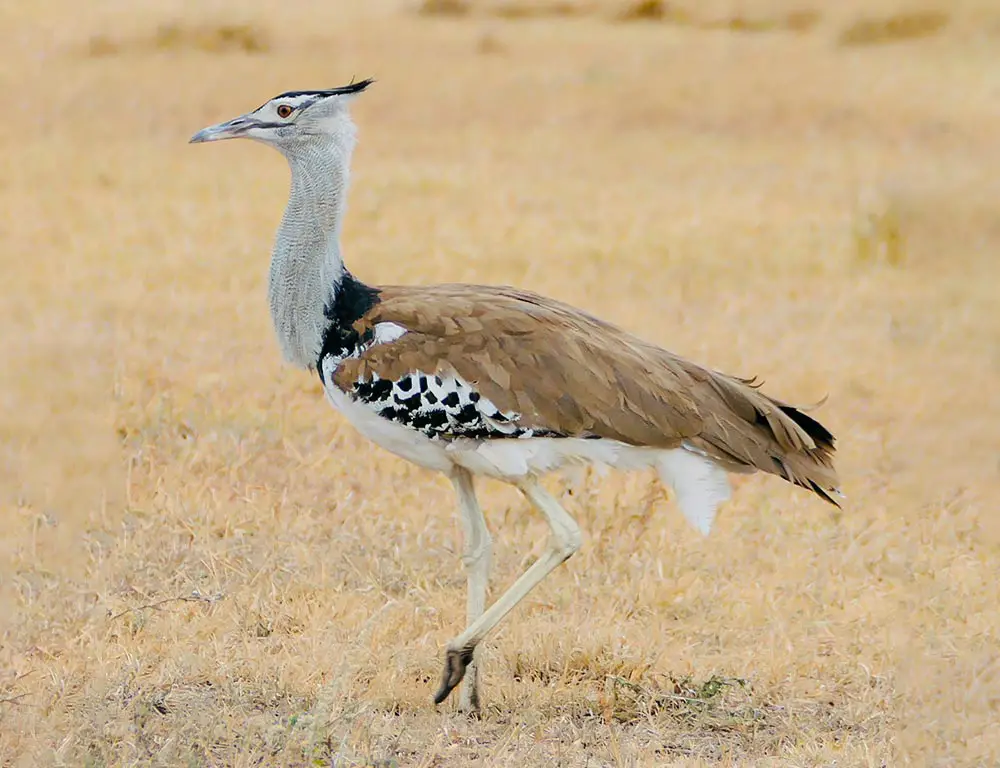
The Nubian bustard is a bird belonging to the bustard family. It is a medium to large-sized bird found in the sparsely vegetated interface between the southern margins of the Sahara desert and the northern part of the Sahel.
It can be found in countries such as Burkina Faso, Cameroon, Chad, Mali, Mauritania, Niger, Nigeria, and Sudan. This bird’s natural habitat includes dry savannas and subtropical or tropical dry shrubs.
The Nubian bustard has a unique appearance with its long legs and neck, as well as its distinctive white and black plumage.
It is a ground-dwelling bird and relies on its ability to blend in with its surroundings to avoid predators.
Unfortunately, the Nubian bustard is considered a vulnerable species, with threats including habitat loss and hunting in some areas.
Conservation efforts are needed to ensure the survival of this remarkable bird.
Scientific classification:
| Kingdom | Animalia |
| Phylum | Chordata |
| Class | Aves |
| Order | Otidiformes |
| Family | Otididae |
| Genus | Neotis |
| Species | N. nuba |
To Recap
Chad is home to a fascinating array of bird species that often go unnoticed. From the elusive Arabian Bustard to the vibrant Abyssinian Roller, these birds bring a unique charm to Chad’s diverse landscapes.
Exploring the country’s rich birdlife not only offers a deeper appreciation for its biodiversity but also underscores the importance of conservation efforts to protect these lesser-known avian treasures.
Whether you are a dedicated bird enthusiast or simply an admirer of nature’s wonders, Chad’s hidden avian gems are a reminder of the countless discoveries waiting to be made in our natural world.